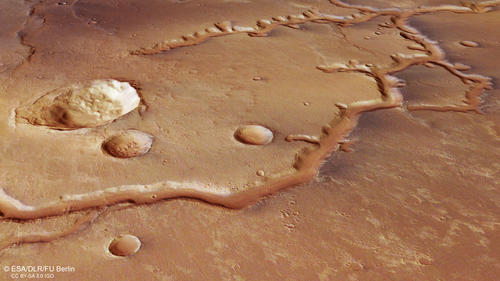The Nirgal Vallis river valley on Mars
Nirgal Vallis is the relict of a stream that once flowed over the surface of Mars. It is a typical example of an amphitheater-headed valley, characterized by steep-sided valley walls, smooth valley floors, and U-shaped cross sections. This kind of valleys has short tributaries with semi-circular head terminations. Examples on Earth include valleys in the Atacama Desert in Chile, on the Colorado Plateau, and on the Hawaiian islands. Apart from Nirgal Valles, Nanedi Valles and Echus Chasma headwater region are prominent examples of amphitheater-headed valleys on Mars.
The nearly 700 kilometers long Nirgal Vallis with its tributaries dissects old volcanic plains, lava flows, and eolian deposits. The east-west orientation of the main valley follows a regional trend of tectonic features seen also in the nearby Valles Marineris canyon system. The flat valley floor of Nirgal Vallis is widely covered by transverse dunes, which indicate wind directions more or less parallel to the valley walls. The images shown here cover the upstream reach of Nirgal Vallis, which is about 200 meters deep and about 2 kilometers wide. 400 kilometers farther to the East, the valley opens out into the much larger Uzboi Valles that has presumably been occupied by a lake in the past.
Nirgal Vallis is morphologically similar to terrestrial sapping valleys that form by headward erosion and undercutting triggered by groundwater seepage. The absence of a dendritic valley network feeding the main valley argues against precipitation and overland flow. With the help of scaled sandbox experiments scientists showed that a sapping origin of Nirgal Vallis is a possibility, if it was fed by a groundwater source. Sapping valleys on Earth, attributed to undermining and collapse of the walls by seepage, mostly occur in unconsolidated sediments with a permeable aquifer.
